| Pages:
1
..
10
11
12
13 |
byko3y
National Hazard
   
Posts: 721
Registered: 16-3-2015
Member Is Offline
Mood: dooM
|
|
woelen, to produce ClO2 in a reducing medium you need to draw it from the mixture as fast as it is forming:
HClO3 + HCl => HClO2 + HOCl
ClO2 + H2O => HClO3 + HClO2
And chlorine reacts with bromide, leading to Br2, unless you draw it from the reaction.
Anyway, I think ClO3- is overkill, and hypochlorite can do the job. Then you just leave your bromine to evaporate with distillation column, so BrCl
just flies away.
mr.crow, AFAIK there's not NaBr3/KBr3 compound.
|
|
|
blargish
Hazard to Others
  
Posts: 166
Registered: 25-9-2013
Location: Canada
Member Is Offline
Mood: Mode Push
|
|
I'm pretty sure the tribromide ion does exist in a manner similar to the triiodide ion, where iodine can dissolve into NaI/KI solutions due to the
formation of [I3]<sup>-</sup>. (you cannot necessarily isolate NaI3/KI3)
BLaRgISH
|
|
|
byko3y
National Hazard
   
Posts: 721
Registered: 16-3-2015
Member Is Offline
Mood: dooM
|
|
Even if this compound exists - I don't think it will somehow prevent bromine distillation.
|
|
|
j_sum1
Administrator
       
Posts: 6320
Registered: 4-10-2014
Location: At home
Member Is Offline
Mood: Most of the ducks are in a row
|
|
Thanks for resurrecting this thread. I can see that I will need to take the time to read the whole thing. A couple of comments before I do...
1. The thread emerged just moments after I had completed an extraction of Br2 from NaBr using acidified permanganate as an oxidant. I wanted some
bromine dissolved in a non-polar solvent for my students to investigate saturation in lipids. I know I could have used the bromine water available,
but, you know oil and water don't mix that well.
2. Making a decent amount of Br2 for my element collection has been on my short list for a while. I have put it off until after my next glassware
purchase. I may as well have the stuff contained. I have almost decided on a displacement of NaBr using Cl2 gas. I know that there is some chance
of getting the interhalide compound BrCl but I understand that that is fairly minimal. (source -- youtube clip entitled something along the lines of
"my favourite way to produce bromine".) Based on woelen's post I might however revisit the electrolysis idea. Mrhomescientist has a nice clip on
that and I have read woelen's linked page in the past.
3. I thought this thread was going to be about sources of bromine compounds for use as a starting reagent. I have some reagent grade NaBr but
wondered about other sources. In my section of the world it is not possible to find bromine salts. I understand that they are quite readily available
in some locations as pool chemicals. The most common bromine chemical here is 1-Bromo-3-chloro-5,5-dimethylhydantoin which has the problem of chlorine being present also. I am on the lookout for suitable otc sources if I
can get it. I did come across a mixture of 85% NaDCCA and 15% NaBr. I wondered about the logistics of adding HCl directly to this mix so that the
Cl2 gas is produced in situ with the NaBr with the probable evolution of a mixture of Cl2, ClBr and Br2. I need to do some more research before I try
this.
[end of ramble]
|
|
|
byko3y
National Hazard
   
Posts: 721
Registered: 16-3-2015
Member Is Offline
Mood: dooM
|
|
Quote: Originally posted by j_sum1  | | I have some reagent grade NaBr but wondered about other sources. In my section of the world it is not possible to find bromine salts.
|
I'm sure you can purchase few kilos of it on ebay without any problems.
Looking at this I realize the day will come when some people will not be able to obtain NaCl.
|
|
|
woelen
Super Administrator
        
Posts: 8012
Registered: 20-8-2005
Location: Netherlands
Member Is Offline
Mood: interested
|
|
@byko3y: Tribromide certainly exists, and its formation is responsible for reducing the yield dramatically, if excess bromide is present. Bromine
dissolves very well in a concentrated solution of a bromide salt. By means of distillation, the tribromide can be broken apart and bromine escapes
from the liquid, but if you want a distillationless synthesis (just separating the bromine from the aqueous layer), then the formation of tribromide
is highly undesirable.
Even when distilling, the formation of tribromide is undesirable. The bromine is more tightly bound to the solution and you have to make the solution
hotter. This makes separation from the water less efficient. I know this from personal experience. The distilled bromine then is very wet, a lot of
water also distills over together with the bromine, due to the higher temperature needed to drive off all bromine.
ClO2 also is a nasty beast. On the one hand, it is very reactive when present as gas and it can explode. On the other hand, it reacts very sluggishly
in aqueous solution. It is remarkable how slowly it reacts with many reductors. In the production of bromine (where excess oxidizer is needed to avoid
formation of tribromide ion) the ClO2 can linger for a long time and it can dissolve in the Br2. You do not have to fear explosion of ClO2 in such
cases, but it can be a highly undesirable contaminant of the bromine. For this reason I do not like chlorate as oxidizer in aqueous solution. If you
want to see the effect yourself, just try it. Take some chlorate salt and add a reducing acid mix (e.g. HCl which has chloride as reductor, or dilute
H2SO4 with a little sulfite added which has SO2 as reductor) to the chlorate. You'll see formation of bright yellow ClO2 and you'll also see that it
lingers for hours at least without any reaction.
Hypochlorite can be used as oxidizer for formation of bromine, but it has the disadvantage, that using excess of this oxidizer leads to considerable
losses in aqueous solutions due to easy hydrolysis. Just try this to see it yourself: Take some NaBr, dissolve in some dilute H2SO4 and then add conc.
bleach. You get a point at which there is a lot of bromine. If you go on adding bleach, then quickly the Br2 redissolves again and you get a
piss-yellow solution, which contains hydrolysis products of BrCl (HBrO3, HCl). This issue exists for chlorate used as oxidizer as well. It does not
exist for use of bromate as oxidizer.
NaBr3 and KBr3 cannot be isolated from solution. The cesium salt, however, can be isolated. I made some CsBr3 myself and keep a small sample of it in
my lab, just as a curiosity. It is a red/orange compound.
|
|
|
byko3y
National Hazard
   
Posts: 721
Registered: 16-3-2015
Member Is Offline
Mood: dooM
|
|
Everybody knows iodine forms triiodide, and bromine probaby forms it too, and the problem is that triiodide is just as well water soluble as the
iodide salt. But... what is the atual equilibrium of the trihalide formation? Nobody seems to know.
http://pubs.acs.org/doi/abs/10.1021/ja02202a004
"The solubility of bromine in aqueous solutions of sodium bromide" - James M. Bell , Melville L. Buckley
J. Am. Chem. Soc., 1912, 34 (1), pp 14–15; DOI: 10.1021/ja02202a004
Solubility of bromine in a distilled water is 34 g/L, which is 0.21 mole/L. At 96 g/L concentration of NaBr (0.932 mole/L) solubility of bromine in
water becomes 1.24 mole/L (397 g/L) (original work mentiones 2.48 gram-ATOM/liter).
As you can see, basically one mole of bromide converts into one mole of tribromide at low concentrations, while at higher concentration, something
happens that makes possible for 1.5 more moles of bromine to be soluble in the same solution.
But anyway, the most important thing for us is to know that if we have not high enough concentration of bromide, then it stochiometrically turns all
the bromide into tribromide. But small amount of bromide won't prevent extractive separation.
Basically, you can use excess of oxidizer, which will result in BrCl and Cl2 formation, but I want to remind you that we have 5:1 proportion of Br:Cl.
The main source of ClO2 is from chlorite (NaClO2) in case of HCl oxidation, ph of the solubtion is another question, because at different ph the
products may be different.
I'd say the major pathways that give stochiometric conversion of chlorite are
2 NaClO2 + 2 HCl + NaOCl → 2 ClO2 + 3 NaCl + H2O
and gas-solid reaction
2 NaClO2 + Cl2 → 2 ClO2 + 2 NaCl
Actually, there's a crazy intermediate http://www.sciencedirect.com/science/article/pii/13811169950... having formula BrClO2.
And I want to emphasize that bromine is more readily oxidized than chlorine.
Chemistry of halides high oxidation states is very complex, so I'd say it's all about experimental data. The question is: will the ClO2 be formed at
all in this reaction?
I hope I will try soon to experiment with NaOCl+NaBr, but for now I'm pretty much sure the problem is about ph of the solution.
|
|
|
morganbw
National Hazard
   
Posts: 561
Registered: 23-11-2014
Member Is Offline
Mood: No Mood
|
|
Quote: Originally posted by byko3y  | Everybody knows iodine forms triiodide, and bromine probaby forms it too, and the problem is that triiodide is just as well water soluble as the
iodide salt. But... what is the atual equilibrium of the trihalide formation? Nobody seems to know.
http://pubs.acs.org/doi/abs/10.1021/ja02202a004
"The solubility of bromine in aqueous solutions of sodium bromide" - James M. Bell , Melville L. Buckley
J. Am. Chem. Soc., 1912, 34 (1), pp 14–15; DOI: 10.1021/ja02202a004
Solubility of bromine in a distilled water is 34 g/L, which is 0.21 mole/L. At 96 g/L concentration of NaBr (0.932 mole/L) solubility of bromine in
water becomes 1.24 mole/L (397 g/L) (original work mentiones 2.48 gram-ATOM/liter).
As you can see, basically one mole of bromide converts into one mole of tribromide at low concentrations, while at higher concentration, something
happens that makes possible for 1.5 more moles of bromine to be soluble in the same solution.
But anyway, the most important thing for us is to know that if we have not high enough concentration of bromide, then it stochiometrically turns all
the bromide into tribromide. But small amount of bromide won't prevent extractive separation.
Basically, you can use excess of oxidizer, which will result in BrCl and Cl2 formation, but I want to remind you that we have 5:1 proportion of Br:Cl.
The main source of ClO2 is from chlorite (NaClO2) in case of HCl oxidation, ph of the solubtion is another question, because at different ph the
products may be different.
I'd say the major pathways that give stochiometric conversion of chlorite are
2 NaClO2 + 2 HCl + NaOCl → 2 ClO2 + 3 NaCl + H2O
and gas-solid reaction
2 NaClO2 + Cl2 → 2 ClO2 + 2 NaCl
Actually, there's a crazy intermediate http://www.sciencedirect.com/science/article/pii/13811169950... having formula BrClO2.
And I want to emphasize that bromine is more readily oxidized than chlorine.
Chemistry of halides high oxidation states is very complex, so I'd say it's all about experimental data. The question is: will the ClO2 be formed at
all in this reaction?
I hope I will try soon to experiment with NaOCl+NaBr, but for now I'm pretty much sure the problem is about ph of the solution.
|
You seem to have a better understanding of the chemistry than I do, however, unless you have more need to understand the chemistry, versus actually
getting the product????
There are some tried/proven methods here???
If you life, is as a research chemist then, by all means, do your experiments, I bow to you.
If you just need the element sir, then you do not need to reinvent the wheel.
For me, the years are passing and time is becoming a factor, I lean on others experience.
[Edited on 4-6-2015 by morganbw]
|
|
|
ScienceHideout
Hazard to Others
  
Posts: 391
Registered: 12-3-2011
Location: In the Source
Member Is Offline
Mood: High Spin
|
|
Quote: Originally posted by morganbw  |
You seem to have a better understanding of the chemistry than I do, however, unless you have more need to understand the chemistry, versus actually
getting the product????
There are some tried/proven methods here???
If you life, is as a research chemist then, by all means, do your experiments, I bow to you.
If you just need the element sir, then you do not need to reinvent the wheel.
For me, the years are passing and time is becoming a factor, I lean on others experience.
[Edited on 4-6-2015 by morganbw] |
morganbw,
If you just do chemistry for the hell of it, perhaps you should try a different hobby. Byko3y is doing chemistry the RIGHT way. Why would anyone want
to do something that they don't understand?
Everyone should aspire to know what they do and do what they know, and some are better at it than others. If you are jealous at the incredible
understanding byko3y has with this topic, good. I am too, and it comes with years and years of discipline and study. However, I don't think that
snotty remarks will better YOUR understanding. Only you can do that.
hey, if you are reading this, I can't U2U, but you are always welcome to send me an email!
|
|
|
byko3y
National Hazard
   
Posts: 721
Registered: 16-3-2015
Member Is Offline
Mood: dooM
|
|
NaOCl + 2NaBr + H2SO4 => Br2 + NaCl + Na2SO4 + H2O
150 g of 3.7% of NaOCl = 0.075 moles
35 ml of 35% H2SO4 (0.125 moles)
12 g of KBr (has the same properties as NaBr) = 0.1 mole
Extracted first with hexane 30 g + 10 g + 12 g + 12 g
Then I added 50 more grams of NaOCl, keeping the solution acidic. The result you can see on the last picture. I don't think that addition changed
anything in terms of bromine yield, just some more chlorine and bromine chloride was created. You can compare the color https://en.wikipedia.org/wiki/Bromine_monochloride
First extraction (30 g hexane added) :
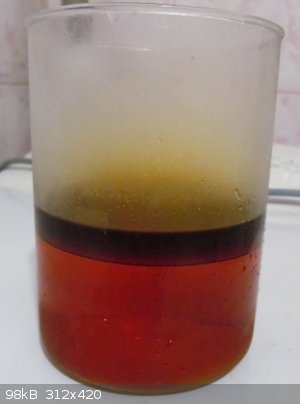
Second etraction (10 g more added) :
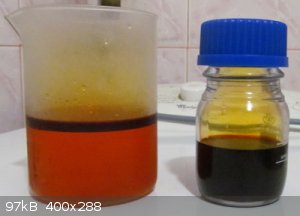
Fourth extraction (+2x10g) :
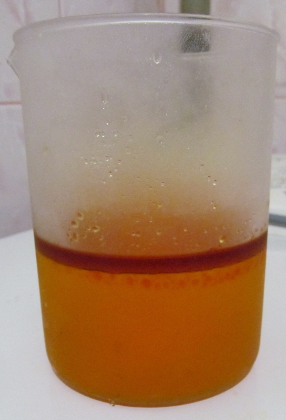
After addition of more 50 g of NaOCl solution and 12 g of hexane (the hexane layer had transparent red color, not shown):
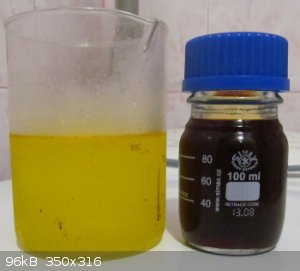
I'd say that extraction leads to even less byproducts than distillation, because the BrCl has a chance to react with bromides, yielding more Br2.
Probably my final product contains a decent amount of BrCl, but it's at least 80% bromine. For some reason it smokes in air, probably it's a mixture
of Br2+BrCl.
If you use slightly less than stochiometric amount of hypochlorite and use extraction for bromine separation, than you will leave something like 10%
of bromine in the solution, but the extracted bromine will be 95%+ pure.
Bromine attacks polypropylene, so use glass or PTFE stoppers. I've used glass stopper tappered with PTFE and sealed with paraffin.
[Edited on 4-6-2015 by byko3y]
|
|
|
Oscilllator
National Hazard
   
Posts: 659
Registered: 8-10-2012
Location: The aqueous layer
Member Is Offline
Mood: No Mood
|
|
ByKo3y, if you conducted your experiment in a brightly lit room you could have contaminated your hexane with hexane chlorides, since the UV light
present would cause the bromine to react with the hexane.
Also, it is highly probably that your hexane is not very pure and contains some alkanes, especially if you distilled it from petrol and the like. If
you want to test for the presence of alkenes you can add a very small amount of your bromine to some hexane, and then observe to see if the red colour
disappears. If it does, your hexane is contaminated.
|
|
|
byko3y
National Hazard
   
Posts: 721
Registered: 16-3-2015
Member Is Offline
Mood: dooM
|
|
Oscilllator, you are so right. Today at the morning I found the glass stopper popped high in the air and strong stream of something was coming from
the bottle. Most likely it is indeed HBr.
Also, bromine has poor solubility in hexane - I was too stupid to use it, but it was too late, because when I realized I'm using the wrong non-polar
solvent, the experiment was almost over.
My hexane is 99% pure reagent grade. No, it does not contain any olefins.
So there will be no report on yields, sorry.
I'd say that bromine is a really nice reagent for alkanes halogenation ^_^. Much more usefull than chlorine that boils at -34°C. You can halogenate
hydrocarbons starting from butane/isobutane/butylene using a home freezer. Nice way to 2-butanol/tert-butanol.
PS: I've just understood I can actually measure the amount of hexane that was halogenated. However, there will be no way to distingiush between
chlorinated and brominated.
[Edited on 5-6-2015 by byko3y]
|
|
|
morganbw
National Hazard
   
Posts: 561
Registered: 23-11-2014
Member Is Offline
Mood: No Mood
|
|
Quote: Originally posted by ScienceHideout  | Quote: Originally posted by morganbw  |
You seem to have a better understanding of the chemistry than I do, however, unless you have more need to understand the chemistry, versus actually
getting the product????
There are some tried/proven methods here???
If you life, is as a research chemist then, by all means, do your experiments, I bow to you.
If you just need the element sir, then you do not need to reinvent the wheel.
For me, the years are passing and time is becoming a factor, I lean on others experience.
[Edited on 4-6-2015 by morganbw] |
morganbw,
If you just do chemistry for the hell of it, perhaps you should try a different hobby. Byko3y is doing chemistry the RIGHT way. Why would anyone want
to do something that they don't understand?
Everyone should aspire to know what they do and do what they know, and some are better at it than others. If you are jealous at the incredible
understanding byko3y has with this topic, good. I am too, and it comes with years and years of discipline and study. However, I don't think that
snotty remarks will better YOUR understanding. Only you can do that. |
We should perhaps share a box of tissues
I actually admire (byko3y ) he seems to be well grounded and a thinker (that is admirable).
Using known reactions does not imply a lack of understanding, and it for sure does not mean (just for the hell of it).
I have seen some who even consider this as a part of research.
I am not able to type very well this day, broke a shoulder blade as well as a leg yesterday. 
|
|
|
byko3y
National Hazard
   
Posts: 721
Registered: 16-3-2015
Member Is Offline
Mood: dooM
|
|
For some reason nobody says about bromine cumulative toxicity, and it actually exists. I've got slightly poisoned by it, because I was sure it is
completely safe until you can breath:
"Potassium bromide (KBr) is a salt, widely used as an anticonvulsant and a sedative in the late 19th and early 20th centuries, with over-the-counter
use extending to 1975 in the US...
Bromide ion is a cumulative toxin with a relatively long half life (in excess of a week in humans)".
Symptoms: reduced cardiac activity, low arterial pressure, general weakness, headache, memory loss, skin rash, decreased skin sensitivity, general
depression, bronchitis, conjunctivitis, damage to the kidneys, delirium.
Antidote - sodium chloride and a lot of water.
This shit needs a lot of time to be removed from the body  I have to admit that
breathing chlorine on a regular basis is much safer. I have to admit that
breathing chlorine on a regular basis is much safer.
|
|
|
Brom
Hazard to Self
 
Posts: 94
Registered: 19-7-2015
Member Is Offline
Mood: No Mood
|
|
Bromine source and synthesis
I use the the method from my old high school chemistry book. NaBr+MnO2+dil. H2SO4. If you have an all glass distillation setup this is definitely the
way to go. Very fast and simple.
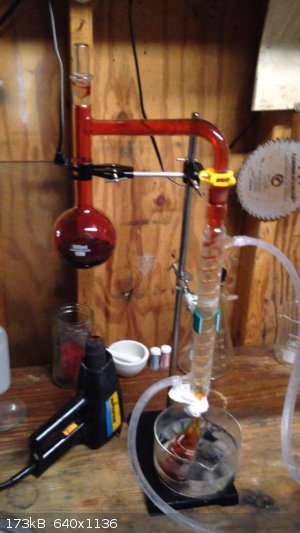
|
|
|
Brom
Hazard to Self
 
Posts: 94
Registered: 19-7-2015
Member Is Offline
Mood: No Mood
|
|
Bromine source and synthesis
I was able to obtain approx. 10 ml or so in about 15 minutes using very small quantities of reagents. As soon as I get a suitable storage container I
will scale it up a bit and make a larger amount.
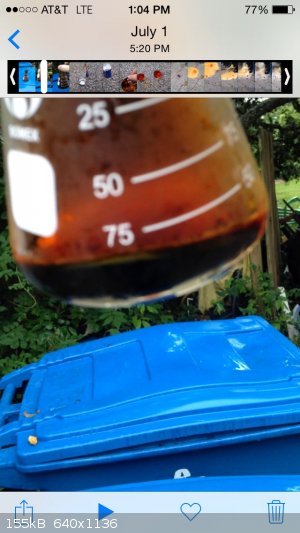
|
|
|
diggafromdover
Hazard to Self
 
Posts: 84
Registered: 24-2-2015
Location: New Hampshire
Member Is Offline
Mood: Inconherent
|
|
Very nice using heat gun as heat source. Where I come from their main use is thawing pipes and occasionally setting fire to the buildings in which
the pipes are being thawed.
Enjoying second childhood with REAL chemistry set.
|
|
|
Brom
Hazard to Self
 
Posts: 94
Registered: 19-7-2015
Member Is Offline
Mood: No Mood
|
|
I had a feeling someone would notice my heating method. I need to get a proper heating mantle but they cost as much as the entire distillation
apparatus! But in the meantime the heating gun works pretty well.
|
|
|
diggafromdover
Hazard to Self
 
Posts: 84
Registered: 24-2-2015
Location: New Hampshire
Member Is Offline
Mood: Inconherent
|
|
I just bought a used Fisher Thermix for $15 plus shipping (more) but I will give your method a shot.
Enjoying second childhood with REAL chemistry set.
|
|
|
ChemPlayer_
Harmless

Posts: 28
Registered: 21-6-2015
Location: Asia
Member Is Offline
Mood: Synthetic
|
|
Awesome set up Brom - congratulations!
I see ice in the waterbath, but how cold do you have the water in the condenser? My problem has always been that the bromine is so volatile that some
of it escapes to the atmosphere and it's very difficult to condense.
|
|
|
agent_entropy
Hazard to Self
 
Posts: 91
Registered: 17-7-2006
Location: U.S.
Member Is Offline
Mood: No Mood
|
|
@ChemPlayer_ I find that circulating a bucket of icewater through the condenser using a pump for a small garden fountain works well and condenses the
vast majority of the bromine.
|
|
|
Brom
Hazard to Self
 
Posts: 94
Registered: 19-7-2015
Member Is Offline
Mood: No Mood
|
|
I just filled a 2 gallon jug half way with a ice and the rest water. Then I use a small fountain pump for circulation. With a 300 mm graham condenser
I get 100% condensation.
|
|
|
Brom
Hazard to Self
 
Posts: 94
Registered: 19-7-2015
Member Is Offline
Mood: No Mood
|
|
Also what I like about this method is that you simply charge your flask with the required materials and the reaction does not start till you apply
heat. No need for an addition funnel as with the H2O2 method.
|
|
|
Brom
Hazard to Self
 
Posts: 94
Registered: 19-7-2015
Member Is Offline
Mood: No Mood
|
|
Nice agent entropy. Great minds Think alike. I think we posted the same thing at the same time
|
|
|
Brom
Hazard to Self
 
Posts: 94
Registered: 19-7-2015
Member Is Offline
Mood: No Mood
|
|
Never mind I looked at the post times and you beat me to it by 4 minutes. But seriously bucket of ice with $20 fountain pump from lowes works
wonderfully
|
|
|
| Pages:
1
..
10
11
12
13 |